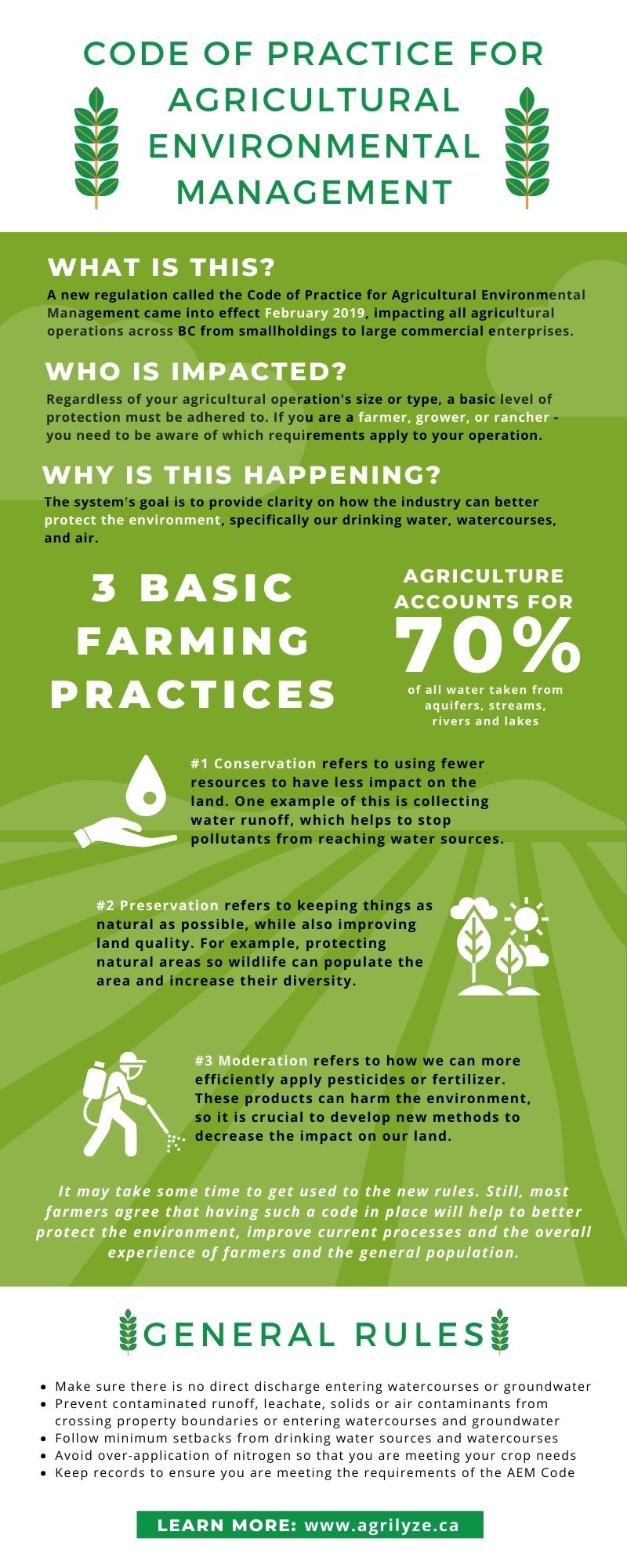Code of Practice for Agricultural Environmental Management – Introduction
Environmental challenges may be keeping agricultural operations from achieving full potential in their respective industries.
However, through good stewardship and the use of best management practices, farmers can improve the health of animals and crops and increase farm profits.
To get started, farmers should evaluate their farm and adopt practices suited to it so that they can protect their investments and the environment.
In February 2019, a new regulation called the Code of Practice for Agricultural Environmental Management came into effect, impacting all agricultural operations across BC from smallholdings to large commercial enterprises.
Based on the code, regardless of your agricultural operation’s size or type, a basic level of protection must be adhered to. There are additional measures for operations that are in high-risk areas or who are operating during high-risk conditions.
Examples of high-risk areas are:
- Where precipitation levels are 600mm or more between October 1 – April 30,
- Over vulnerable aquifers where groundwater is susceptible to pollution or contamination from the land, and
- Phosphorus-affected areas of land that drain into surface water bodies that may be affected by high levels of phosphorus
If you would like to find out if you are in a high-risk area, click here.
Taking care of the land is an all-encompassing idea, an unwritten agreement between farmers and the vast resources that facilitate their role as nurturers of the earth. This relationship determines a farm’s success; by improving farming productivity and increasing efficiency, a farmer’s job can become more profitable.
However, to promote sustainability in the long run, farmers must adapt and build new skills, knowledge and technical competence to make better decisions that will help them manage their operations more effectively.
The Code of Practice for Agricultural Environmental Management is a set of rules created to clarify how the industry can better protect the environment, specifically our drinking water, watercourses, and air.
As farming is continually changing, the AEM Code can help to identify problem areas and ways to manage environmental challenges with detailed guidelines that farmers can easily apply. A systems-oriented approach can help address the problematic issues associated with the complexity of food and other production systems in different ecologies and locations.
We can take time to consider some basic farming practices that contribute toward the betterment of our planet. We will get into the specific requirements of the Code of Practice for Agricultural Environmental Management further into the series, but for now, let’s quickly visit the ideas of conservation, preservation and moderation.
- Conservation refers to using fewer resources to have less impact on the land. One example of this is collecting water runoff, which helps to stop pollutants from reaching water sources.
- With preservation, the goal is to keep things as natural as possible while also improving land quality. One example is to protect natural areas so that wildlife can populate the area and increase their diversity.
- Then, we can practice moderation when it comes to the application of pesticides or fertilizer. These products can harm the environment, so it is crucial to develop new methods to decrease their impact on our land.
There’s more to it; this is just a start (for a future blog post on this topic, send us an email!). For now, it is essential to consider –
A farmer’s land is full of opportunity: The intimate relationship farmers have with nature can be viewed as an opportunity to balance interacting elements (water, plants, soil, and animals), protect resources and produce healthy, sellable and good-tasting food.
We are clear on the fact that agriculture sustains us: As farmers, it defines who we are, what we do and why we do it. Rather than disrupting our vital ecosystems’ natural balance, we must find ways to increase our knowledge around critical factors like soil systems and water resources.
By understanding, evaluating and managing the benefits of conservation, preservation and moderation, as well as implementing the Code of Practice for Agricultural Environmental Management, we can boost yields, improve sustainability and increase growth and competitiveness in the agricultural market.
Provincial inspectors are being deployed to check in on farmers and may visit on-site to validate if the agricultural site is adhering to the rules. To be best prepared for a visit, ensure that your agricultural operation meets the AEM Code and that you are keeping records for at least five years.
Here are some of the general rules of the Code of Practice for Agricultural Environmental Management:
- Make sure there is no direct discharge entering into watercourses or groundwater
- Prevent contaminated runoff, leachate, solids or air contaminants from crossing property boundaries or entering watercourses and groundwater
- Following minimum setbacks from drinking water sources, watercourses and property boundaries
- Avoid over-application of nitrogen so that agronomic nitrogen application rates are meeting your crop needs
We will be sharing the following topics (AEM Code’s specific requirements) with you over the next ten weeks:
- Introduction
- Agricultural Boilers & Heaters
- Agricultural Composting
- Livestock & Poultry Areas
- Minimum Setbacks
- Nutrient Management
- Record-Keeping
- Storage & Use
- Treatment of Wastewater
- Conclusion / About Agrilyze
By acting now, we are helping farming communities around BC by providing resourceful solutions to farming operations impacting production, livelihood and our ecological footprint.
To kick-off this blog series, we wanted to share an infographic with you. We hope you enjoy this series, and if you have any questions at all, please feel free to reach out to us anytime!



